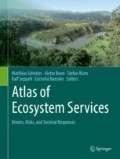Abstract
Pollution of ecosystems by a constantly increasing load of anthropogenic chemicals is a major driver of ecosystem service risk. This chapter summarizes relevant abiotic and biotic processes that determine the persistence, degradation, and ultimate destination of anthropogenic chemicals. It also summarizes research challenges for predicting the ability of an ecosystem to biodegrade an anthropogenic chemical by addressing the following questions: “What makes a chemical available for biodegradation?” and “What makes an ecosystem capable of biodegradation?”
Access this chapter
Tax calculation will be finalised at checkout
Purchases are for personal use only
References
Rockstrom J, Steffen W, Noone K, Persson A, Chapin FS, Lambin EF, et al. A safe operating space for humanity. Nature. 2009;461(7263):472–5.
Swedish Environmental Protection Agency. A non-toxic environment. http://www.swedishepa.se/Environmental-objectives-and-cooperation/Swedens-environmental-objectives/The-national-environmental-objectives/A-Non-Toxic-Environment/. Accessed 19 Oct 2017.
Carvalhais N, Forkel M, Khomik M, Bellarby J, Jung M, Migliavacca M, et al. Global covariation of carbon turnover times with climate in terrestrial ecosystems. Nature. 2014;514(7521):213–7.
Reemtsma T, Berger U, Arp HH, Gallard H, Knepper TP, Neumann M, et al. Mind the gap: persistent and mobile organic compounds—water contaminants that slip through. Environ Sci Technol. 2016;50:10308–15.
Kolvenbach BA, Helbling DE, Kohler HPE, Corvini PFX. Emerging chemicals and the evolution of biodegradation capacities and pathways in bacteria. Curr Opin Biotechnol. 2014;27:8–14.
Ortega-Calvo JJ, Harmsen J, Parsons JR, Semple KT, Aitken MD, Ajao C, et al. From bioavailability science to regulation of organic chemicals. Environ Sci Technol. 2015;49(17):10255–64.
Bosma TNP, Middeldorp PJM, Schraa G, Zehnder AJB. Mass transfer limitation of biotransformation: quantifying bioavailability. Environ Sci Technol. 1996;31(1):248–52.
de Lorenzo V. Systems biology approaches to bioremediation. Curr Opin Biotechnol. 2008;19(6):579–89.
Fester T, Giebler J, Wick LY, Schlosser D, Kastner M. Plant-microbe interactions as drivers of ecosystem functions relevant for the biodegradation of organic contaminants. Curr Opin Biotechnol. 2014;27:168–75.
Harms H, Schlosser D, Wick LY. Untapped potential: exploiting fungi in bioremediation of hazardous chemicals. Nat Rev Microbiol. 2011;9(3):177–92.
Hernandez‐Raquet G, Durand E, Braun F, Cravo‐Laureau C, Godon JJ. Impact of microbial diversity depletion on xenobiotic degradation by sewage‐activated sludge. Environ Microbiol Rep. 2013;5(4):588–94.
Kassen R, Rainey PB. The ecology and genetics of microbial diversity. Annu Rev Microbiol. 2004;58:207–31.
Zhou JZ, Xia BC, Treves DS, Wu LY, Marsh TL, O’Neill RV, et al. Spatial and resource factors influencing high microbial diversity in soil. Appl Environ Microbiol. 2002;68(1):326–34.
Fetzer I, Johst K, Schawe R, Banitz T, Harms H, Chatzinotas A. The extent of functional redundancy changes as species’ roles shift in different environments. Proc Natl Acad Sci U S A. 2015;112(48):14888–93.
Crowther TW, Thomas SM, Maynard DS, Baldrian P, Covey K, Frey SD, van LTA D, Bradford MA. Biotic interactions mediate soil microbial feedbacks to climate change. Proc Natl Acad Sci U S A. 2015;112(22):7033–8.
Classen AT, Sundqvist MK, Henning JA, Newman GS, Moore JA, Cregger MA, et al. Direct and indirect effects of climate change on soil microbial and soil microbial‐plant interactions: what lies ahead? Ecosphere. 2015;6(8):1–21.
Singh BK, Quince C, Macdonald CA, Khachane A, Thomas N, Abu Al-Soud W, et al. Loss of microbial diversity in soils is coincident with reductions in some specialized functions. Environ Microbiol. 2014;16(8):2408–20.
Tobor-Kapłon MA, Bloem J, Römkens P, De Ruiter PC. Functional stability of microbial communities in contaminated soils near a zinc smelter (Budel, The Netherlands). Ecotoxicology. 2006;15(2):187–97.
Blum C, Bunke D, Hungsberg M, Roelofs E, Joas A, Joas R, et al. The concept of sustainable chemistry: key drivers for the transition towards sustainable development. Sustain Chem Pharm. 2017;5:94–104.
Graham DW, Smith VH. Designed ecosystem services: application of ecological principles in wastewater treatment engineering. Front Ecol Environ. 2004;2:199–206.
Cabrol L, Poly F, Malhautier L, Pommier T, Lerondelle C, Verstraete W, et al. Management of microbial communities through transient disturbances enhances the functional resilience of nitrifying gas-biofilters to future disturbances. Environ Sci Technol. 2015;50(1):338–48.
Acknowledgements
This contribution was funded by and contributes to the research topic Chemicals in the Environment (CITE) within the Research Program Terrestrial Environment of the Helmholtz Association.
Author information
Authors and Affiliations
Corresponding author
Editor information
Editors and Affiliations
Rights and permissions
Copyright information
© 2019 Springer International Publishing AG, part of Springer Nature
About this chapter
Cite this chapter
Wick, L.Y., Chatzinotas, A. (2019). Capacity of Ecosystems to Degrade Anthropogenic Chemicals. In: Schröter, M., Bonn, A., Klotz, S., Seppelt, R., Baessler, C. (eds) Atlas of Ecosystem Services. Springer, Cham. https://doi.org/10.1007/978-3-319-96229-0_28
Download citation
DOI: https://doi.org/10.1007/978-3-319-96229-0_28
Published:
Publisher Name: Springer, Cham
Print ISBN: 978-3-319-96228-3
Online ISBN: 978-3-319-96229-0
eBook Packages: Earth and Environmental ScienceEarth and Environmental Science (R0)

